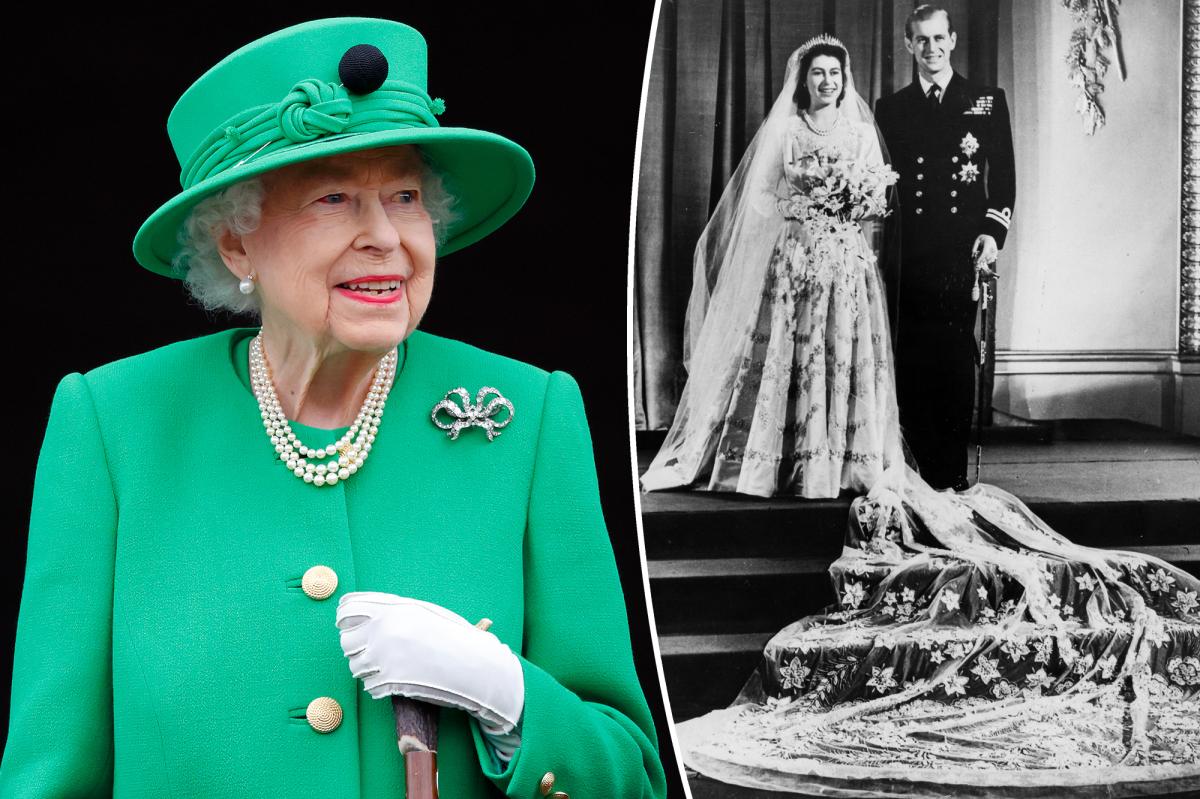
Queen Elizabeth II, the longest-reigning monarch in British history, died at her Balmoral home on Sept. 8, 2022. She was 96 years old.
The ever-stylish royal married the dashing naval officer Prince Philip of Greece on November 20, 1947, in the wedding everyone was waiting for in post-World War II Britain.
Ahead of the big day, speculation about what the 21-year-old princess would wear down the aisle hit a fever pitch; the windows of designer Norman Hartnell’s studio had to be covered up to prevent spying, and there’s even a historical novel about the making of the famous dress, titled “The Gown.”
The stunning garment has a remarkable story behind it, and we’re looking back at the wedding of Princess Elizabeth and Prince Philip with five fascinating facts about her gorgeous dress.

1. The final design was approved less than three months before the wedding.

While many brides these days order their dresses nine months to a year or more in advance, Princess Elizabeth’s gown wasn’t even started until August 1947, according to the Royal Collection Trust — less than three months before her nuptials.
A design sketched by Norman Hartnell, one of the premier fashion designers in England at the time, won out; he called it “the most beautiful dress I had so far made,” per People.
It took the hard work of 350 women to pull off creating the intricately detailed piece in such a short timeframe, and they were all sworn to secrecy to protect any details about Princess Elizabeth’s special day from leaking to the press.
Betty Foster, a then-18-year-old seamstress who worked on the gown in Hartnell’s studio, told the Telegraph that “Americans had rented the flat opposite to see if they could get a glimpse of the dress, and that [Hartnell] had to cover the workroom windows with whitewash and muslin to stop snoopers.”
2. Ordinary women gave Princess Elizabeth their ration coupons to help pay for the dress.

In post-war Britain, austerity measures meant that people had to use clothing ration coupons — and as one can imagine, a designer wedding gown wasn’t exactly within that budget.
The pricey fabric used for Princess Elizabeth’s dress was especially difficult to acquire at the time, as bridesmaid (and cousin of Prince Philip) Lady Pamela Hicks told People.
“Tulle could easily be acquired, whereas duchess satin was so difficult to get in those days,” she said, adding that the bridesmaids wore tulle dresses while the princess’ gown was made of satin with tulle accents.
The British government gave Princess Elizabeth 200 extra ration coupons, per Town and Country, but women around the United Kingdom were so happy to see her get married that they actually mailed her their own vouchers to help cover the dress.
While Hicks said the princess had to mail them back — it was actually illegal to give coupons away — it was a touching show of support for Elizabeth and the monarchy.
“It showed how people wanted to be involved,” the royal bridesmaid said.
3. The princess’ gown was inspired by a Botticelli painting.

According to the Royal Collection Trust, Hartnell’s inspiration for the wedding gown came from an unusual place: the famed Italian artist Sandro Botticelli’s painting “Primavera.”
The word “primavera” means spring in Italian, and the painting features Flora, the goddess of spring, and Venus, the goddess of love and beauty — a perfect way to combine the new beginning of a wedding and also a fresh start after the war.
Much like the floral-trimmed dress in the painting, Princess Elizabeth’s was covered in intricate, crystal-and-pearl-embroidered flower and leaf motifs.
The Royal Collection Trust describes on its website how Hartnell said, “the motifs had to be assembled in a design proportioned like a florist’s bouquet.”
4. The design featured 10,000 seed pearls imported from America.

One detail that stands out on Princess Elizabeth’s wedding gown and elaborate veil? Her look is covered in an astonishing 10,000 seed pearls, all hand-sewn onto the gown in a floral pattern.
While care was taken to ensure the silk and satin were produced in Britain (including Lullingstone Castle, Kent, and Dunfermline, Scotland, per the Royal Collection Trust), the gown’s pearls were actually imported from America.
One issue with the silk fabric? The palace had to reassure the public that the silkworms came from China, and not from one of the countries Great Britain fought in the war, like Japan or Italy, according to Town and Country.
5. Princess Elizabeth didn’t try the dress on until her wedding day.

Although members of the royal family obviously have wedding dress fittings like other brides-to-be, it turns out Princess Elizabeth actually didn’t know if her gown fit properly until the morning she got married.
Foster, the aforementioned seamstress, told the Telegraph that Elizabeth’s gown was delivered on the wedding day, “respecting the tradition that it would be unlucky” to try it on beforehand.
While another staff member, Miss Yvonne, went to Buckingham Palace to fit the bride, Foster revealed there were some wedding day jitters involved.
“She told us that the King had offered Princess Elizabeth a drink to steady her nerves but she had refused it.”

Leave a Reply